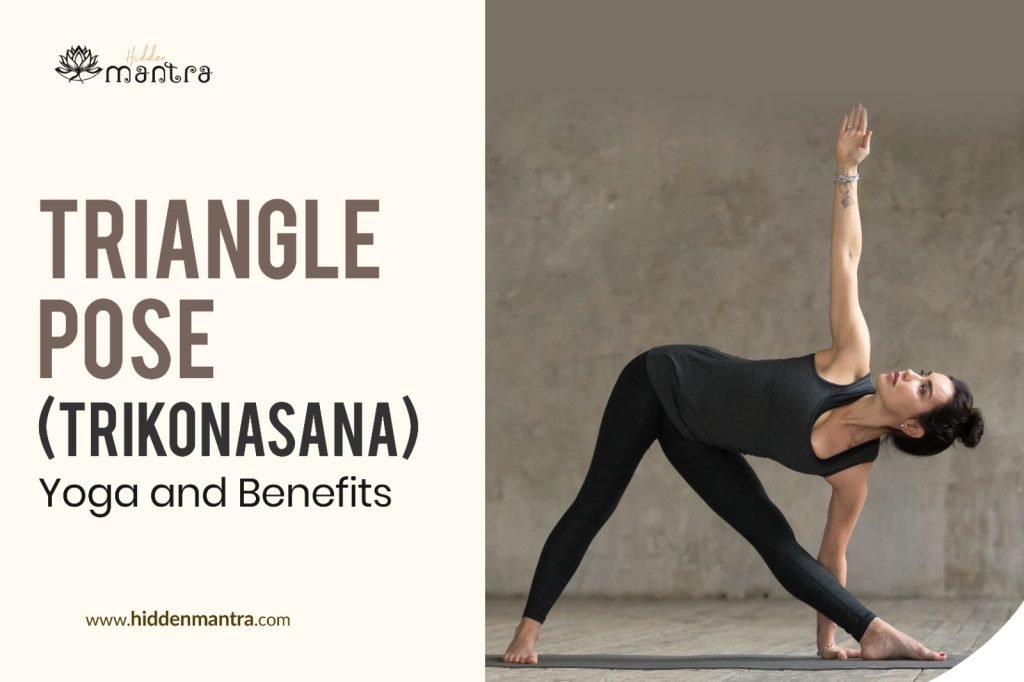Yoga is genuinely popular as it facilitates people to feel better about their bodies and minds. It’s like a special workout that makes you strong and flexible, however, it additionally calms your mind and makes you much less burdened.
Yoga could make your body more bendy and strong, which is right for your bodily fitness. It additionally facilitates you to loosen up and feel much less tense, which is ideal for your intellectual health. When you do yoga, you discover ways to breathe deeply and be a gift, that could make you feel happier and greater at peace, improving your emotional well-being.
In this web blog, we’re going to discover Triangle Pose (Trikonasana) . It’s like a gentle exercise that stretches your legs, hips, and aspects, making you experience more agility and enhancing your stability.
We’ll dive into how this pose can calm your thoughts and decrease pressure. It’s like an intellectual breather that enables you to relax and feel less disturbed, leaving you feeling extra at peace. We’ll discover how Trikonasana can enhance your power and vitality. It’s like a recharge in your inner battery, assisting you to experience more alive and ready to take on the day.
Understanding Triangle Pose (Trikonasana)
Triangle Pose, known as Trikonasana in yoga, is a fundamental standing yoga pose. The name “Trikonasana” comes from two Sanskrit words: “Trikona,” which means “triangle,” and “Asana,” which means “pose” or “posture.”
In Trikonasana, you start by standing with your feet together. Then, you take a step back with one foot, creating a wide stance. This wide stance is crucial for maintaining balance and stability during the pose. Your feet should be parallel to each other, aligning with the shorter edges of your yoga mat.
As you transition into the pose, you rotate your front foot outward, typically at a 90-degree angle, so your toes point to the side. Your back foot may turn slightly inward to assist with balance. This positioning of the feet is vital to ensure proper alignment and a strong foundation for the pose.
Now, with your feet in the right position, you raise both arms to shoulder height, extending them parallel to the ground. This creates a horizontal line with your arms. As you bend your body to the side over your front leg, your arms and torso form a triangle shape. One arm extends downward, reaching toward your front foot or shin, while the other arm reaches upward toward the ceiling. This triangle shape symbolizes the essence of the pose.
Throughout Trikonasana, it’s essential to focus on your alignment, maintaining a straight line from the crown of your head down through your spine and to your heels. This pose offers a wonderful stretch for the legs, hips, and side of the body while enhancing balance and posture. Remember to breathe deeply and find a comfortable depth in the pose that suits your body’s abilities, avoiding overexertion or strain.
The Physical Benefits of Triangle Pose: Strength and Flexibility
The Triangle Pose(Trikonasana), or Trikonasana in yoga, offers a range of physical benefits, primarily focusing on enhancing both strength and flexibility.
- Strengthens Your Legs: When you do the Triangle Pose, your legs have to work hard to hold you up. This makes your thigh muscles, especially the big ones in front (called quadriceps), and the muscles at the back of your thighs (hamstrings), stronger. It’s like giving your legs a workout.
- Engages Your Core: To stay balanced in this pose, you use your tummy muscles, known as the core muscles. They help you keep steady and straight. This engagement not only gives you a strong core but also helps with stability.
- Stretches Your Sides: Imagine your body as a rubber band. In the Triangle Pose, you stretch one side of your body from your fingertips down to your toes. This stretch reaches all the way through your spine, waist, and even the muscles between your ribs (intercostal muscles). It’s like giving your sides a nice, long stretch.
- Better Posture and Comfort: If you sit a lot during the day, this pose can be a game-changer. It helps improve your posture because it strengthens the muscles that help you stand tall. Plus, it can ease discomfort that comes from sitting too much, like a sore back or stiff waist.
So, in simple terms, doing the Triangle Pose (Trikonasana) in yoga can make your legs strong, keep your tummy tight, stretch your sides, and make you feel more comfortable after sitting for a long time. It’s like a mini workout and stretch session all rolled into one pose.
The Mental and Energetic Benefits of Triangle Pose
Mental Benefits, Including Enhanced Concentration and Stress Reduction:
- Enhanced Concentration: Triangle Pose demands focused attention to maintain proper alignment and balance. As you engage in the pose, your mind naturally tunes into the sensations within your body and the subtleties of your posture. This heightened concentration helps to clear mental clutter and distractions, allowing you to be fully present in the moment. Over time, this improved concentration can carry over into other aspects of your life, making it easier to stay focused on tasks and activities.
- Stress Reduction: One of the core principles of yoga is the connection between the body and the mind. Triangle Pose combines physical postures with controlled breathing, which triggers the relaxation response in the nervous system. The deep stretches and mindful breathing in this pose stimulate the parasympathetic nervous system, promoting relaxation and reducing the production of stress hormones. As a result, regular practice of Triangle Pose can help manage stress and anxiety, fostering a greater sense of mental calm and emotional balance.
Expanding the Ribcage and Creating a Sense of Spaciousness in the Mind:
The physical act of opening the chest and expanding the ribcage in Triangle Pose (Trikonasana) can have a profound impact on the mind:
- Improved Breathing: When you open the chest and expand the ribcage in Triangle Pose, you create more space for your lungs to expand fully. This allows for deeper and more controlled breathing. Deep, diaphragmatic breathing is known to calm the mind and reduce stress, as it signals to the body that it is safe and relaxed.
- Energetic Connection: In yoga philosophy, the heart center (Anahata chakra) is associated with love, compassion, and openness. Expanding the chest in a Triangle Pose can activate and open this energy center, creating a sense of emotional spaciousness. As the chest opens, you may also experience a feeling of vulnerability, which can lead to a sense of emotional release and a clearer state of mind.
The Concept of “Prana” and Energy Blockages:
In yogic philosophy, “prana” is the life force energy that flows through the body. This energy is said to be responsible for physical, mental, and emotional well-being. Blockages or stagnation in the flow of prana can lead to various issues, including physical discomfort and mental agitation.
Triangle Pose can help release energy blockages in several ways:
- Stretching and Twisting: The pose involves stretching and twisting of the torso, which can release tension and stagnant energy in the spine and surrounding muscles. This can help prana flow more freely.
- Breath Awareness: In Triangle Pose, you are encouraged to focus on your breath. Breath awareness helps you become attuned to the subtle movements of prana within your body. As you breathe deeply and mindfully, you may notice a sense of energy flowing more smoothly.
Modifications and Variations of Triangle Pose (Trikonasana)
Modifications:
- Use a Block: If you have difficulty reaching the floor with your hand in the full expression of Triangle Pose, place a yoga block under your hand for support. You can adjust the height of the block to make it more accessible.
- Bend Your Knee: If you have tight hamstrings or are a beginner, consider bending your front knee slightly. This modification reduces the intensity of the stretch and makes it easier to maintain balance.
- Widen Your Stance: If you find it challenging to balance or stretch deeply in the pose, widen your stance by taking a larger step between your feet. This provides more stability and may make the pose more comfortable.
- Use a Wall: Stand with your back against a wall for added support and balance. This can be especially helpful for beginners or those working on improving their alignment.
- Top Hand on Hip: Instead of reaching the top arm straight up toward the ceiling, place your hand on your hip. This modification can be useful if you have shoulder issues or if reaching overhead is uncomfortable.
Variations:
- Revolved Triangle Pose (Parivrtta Trikonasana): In this variation, you start in Triangle Pose (Trikonasana) and then twist your torso to reach the opposite hand to the outside of the front foot. This deepens the stretch and adds a twisting element, which can enhance spinal mobility.
- Extended Triangle Pose (Utthita Trikonasana): In Extended Triangle Pose, the top arm is extended horizontally over the head, parallel to the floor, instead of reaching straight up. This variation intensifies the stretch along the sides of the body.
- Bound Triangle Pose: In this variation, you reach the top arm behind your back and the bottom arm under your front leg, attempting to clasp your hands together. This variation provides a deeper shoulder and chest stretch.
- Half Moon Pose (Ardha Chandrasana): Half Moon Pose is a standing balance pose that incorporates elements of Triangle Pose. It involves balancing on one leg with the other leg extended horizontally and one hand on the floor. This pose enhances core strength and balance.
- Revolved Half Moon Pose: Combine the elements of a Revolved Triangle and Half Moon Pose for a challenging variation. You start in Half Moon Pose and then twist your torso to bring the top hand down to the floor while keeping the bottom leg extended.
- Chair Triangle Pose: In this variation, you perform Triangle Pose while seated in a chair. This is a great option for individuals with mobility limitations or those who find it challenging to practice the pose standing.
- Dynamic Triangle Pose: Instead of holding the pose statically, you can flow in and out of Triangle Pose. Move with your breath, inhaling to lift back up and exhaling to deepen the stretch. This dynamic version can improve flexibility and balance.
Triangle Pose (Trikonasana) for Beginners
Here are step-by-step instructions for practicing Triangle Pose (Trikonasana) for beginners:
- Stand Straight: Start by standing up straight with your feet together.
- Take a Step: Take a step back with one foot so your feet are about 3-4 feet apart. This helps with balance.
- Turn Your Foot: Turn your right foot so it points to the side, like the hands on a clock at 3:00.
- Line Up Your Hips: Imagine your hips are like a square box. Turn them to face the side where your foot is pointing (the short side of your mat).
- Arms Out: Stretch your arms out to the sides like you’re making a “T” shape with your body.
- Lean Over: As you breathe out, move your hips to the right (the same direction as your foot) while keeping them in line with the front of your mat. Reach your right hand down toward your right ankle, leg, or use a block for support. Your left arm should stay up.
- Stay Straight: Keep your body in one straight line, not leaning forward or backward.
- Open Your Chest: Open your chest and roll your left shoulder back, like you’re showing off your chest.
- Look Where You Like: Choose a place to look that’s comfortable for your neck. You can look up, forward, or down.
- Breathe: Take slow, deep breaths to stay calm and balanced.
- Hold It: Stay in this pose for 30 seconds to 1 minute, while you keep breathing and concentrating.
- Switch Sides: To come out of the pose, breathe in, engage your belly muscles, and stand back up straight. Turn your feet the other way, with your left foot pointing to the short side of your mat, and repeat the steps on your left side.
Incorporating Triangle Pose (Trikonasana) into Your Yoga Practice
Incorporating Triangle Pose (Trikonasana) into your yoga practice can provide a range of physical and mental benefits. Here’s how you can integrate this pose into your routine:
When to Practice Triangle Pose:
You can practice Triangle Pose (Trikonasana) at various points in your yoga routine, depending on your goals:
- Warm-Up: Start with Triangle Pose in your warm-up routine to gently stretch and awaken your muscles and improve flexibility.
- Main Sequence: Include it as part of your main yoga sequence to work on strength and balance.
- Cool-Down: End your practice with Triangle Pose during your cool-down to relieve tension and enhance flexibility.
Tips for Practicing Triangle Pose:
- Focus on Alignment: Pay attention to the alignment of your feet, hips, and arms to maintain proper form.
- Use Props: If needed, use a yoga block under your lower hand to make the pose more accessible.
- Breathe Mindfully: Deep, slow breaths are essential. Inhale as you lengthen your body, and exhale as you deepen the stretch.
- Stay Balanced: Keep your gaze steady to help with balance and concentration.
Simple Yoga Sequence with Triangle Pose:
Here’s a basic yoga sequence incorporating Triangle Pose:
- Mountain Pose (Tadasana): Stand tall, feet together, and arms by your sides.
- Forward Fold (Uttanasana): Bend at the hips and reach for your toes, stretching your hamstrings and back.
- Warrior II (Virabhadrasana II): Step one foot back, bend your front knee, and open your arms wide. Engage your core and hips.
- Triangle Pose (Trikonasana): Transition from Warrior II into Triangle Pose on one side, holding for 30 seconds to 1 minute.
- Repeat Triangle Pose on the other side.
- Child’s Pose (Balasana): Kneel on the ground, sit back on your heels, and reach your arms forward to relax.
- Corpse Pose (Savasana): Lie on your back, arms by your sides, and take a few moments to relax and absorb the benefits of your practice.
Benefits of Integrating Triangle Pose:
Incorporating Triangle Pose into your routine can have several advantages:
- Flexibility: It helps stretch your legs, hips, and spine, improving flexibility.
- Strength: Triangle Pose strengthens your legs, core, and back muscles.
- Balance: The pose enhances balance and stability through mindful practice.
- Stress Relief: Deep breathing during the pose can reduce stress and calm your mind.
- Better Posture: Regular practice can improve posture by strengthening your back and core.
Remember, yoga is about listening to your body and progressing at your own pace. With mindful breathing and consistent practice, Triangle Pose can become a valuable part of your yoga routine, helping you reap its physical and mental benefits in a gentle and accessible way.
Precautions and Contraindications
Certainly, here are some important precautions to keep in mind when practicing Triangle Pose (Trikonasana).
- Pregnancy and Recent Injury: If you are pregnant, it’s usually best to avoid deep twists and poses that put pressure on your belly, so Triangle Pose may not be suitable during pregnancy.
If you have a recent injury to your back, hips, or knees, consult a healthcare professional or experienced yoga instructor before attempting Triangle Pose. It’s essential to ensure it won’t exacerbate your condition.
- Medical Concerns or Conditions: If you have any medical concerns, chronic health conditions, or are recovering from surgery, speak to your doctor or a qualified yoga instructor before practicing Triangle Pose. They can provide guidance tailored to your specific situation.
- Proper Alignment: Correct alignment is crucial to avoid strain or injury. Ensure your feet are in the right position, your hips are squared, and your body is in one plane. Proper alignment can help you get the most benefit from the pose while minimizing the risk of discomfort or injury.
- Listen to Your Body: Pay close attention to how your body feels during Triangle Pose. If you experience pain, discomfort, or dizziness, ease out of the pose immediately. Yoga should never cause pain.
- Use Props: If you’re a beginner or have limited flexibility, consider using yoga props like a block under your lower hand to make the pose more accessible and safe.
- Modifications: Don’t hesitate to modify the pose as needed. For example, you can bend your front knee slightly to reduce strain on your hamstrings or use a chair for support.
- Go Slowly: Take your time getting into and out of the pose. Sudden movements can lead to injuries, so move slowly and mindfully.
- Breath Awareness: Keep a steady and deep breath while in the pose. Breathing deeply can help you stay relaxed and focused, reducing the risk of strain.
Triangle Pose (Trikonasana) can offer many benefits, but it’s important to approach it with caution, especially if you have specific health concerns or are new to yoga. Always consult with a healthcare professional or qualified yoga instructor if you’re unsure about its suitability for your individual circumstances. And remember, listening to your body and practicing with proper alignment are key to a safe and enjoyable yoga experience.
Conclusion
In the world of classical yoga, remember that your best yoga partner is already inside you. If you want to learn more about yoga, visit our website, Hidden Mantra, where we share many blogs about yoga.
Triangle Pose (Trikonasana), can be like a trusted friend on your journey to find inner peace. In classical yoga, it’s not just a physical pose; it’s a way to discover the inner calm that’s in all of us. So, explore our blogs to learn more about the wonderful world of yoga. It’s a chance to connect with yourself and find the peace that’s always been a part of you.









